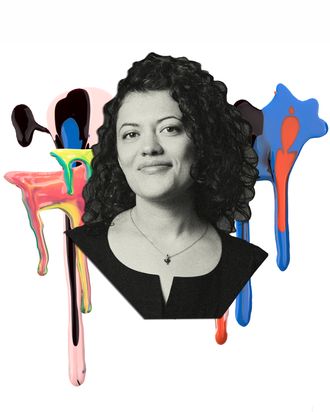
If you walked by New York’s Lincoln Center at any point this summer, you may have noticed a ten-foot disco ball dangling over the fountain that sits between the campus’s three main performance spaces. That was the brainchild of Shanta Thake, Lincoln Center’s first-ever chief artistic officer, who installed a dance floor under the disco ball and scheduled live band performances there throughout the summer.
After moving to New York in 2002 to pursue an acting career, Thake soon realized she was having more fun at her intern gig at the Public Theater than she was running to auditions all over the city. She stayed at the Public for the next 20 years, working her way up to senior associate director while championing programming that would allow the Public’s disparate performance programs to share resources and audiences. She finally left in August 2021, joining Lincoln Center as a creative leader. In her current role, her top priority is widening the organization’s reach on every level, whether that means programming beyond the traditional scope of classical music or introducing a “choose what you pay” ticket-purchase model. One of her first events was a naturalization ceremony for 200 new American citizens, which took place outdoors at the Center. This month, for the reopening of David Geffen Hall, she commissioned the inaugural show, a multimedia jazz piece about San Juan Hill, the largely Black and Puerto Rican neighborhood that was destroyed to build Lincoln Center back in the ’50s.
Thake works alongside ten independent institutions housed on Lincoln Center’s campus that all do their own programming, but she is responsible for the hundreds of events Lincoln Center itself puts on every year. By her estimation, she spends four or five nights a week at some sort of live performance. She lives in Brooklyn with her husband, her 7-year-old son, and sometimes her stepdaughter, who’s at boarding school in Michigan. Here, she shares how she gets it done.
On her morning routine:
A few times a week I get up at 5:30 and do a workout in Prospect Park. There’s a moms’ fitness group that does HIIT. Other times I sleep as long as possible and wake up around 7. I make breakfast for my son and get all of us ready for the day. My husband and I figure out what on earth our night looks like. We’re figuring out who’s seeing a show, if we have a babysitter lined up, who’s making dinner if we’re home. I’m generally opposed to making lunch for my son because I think he should be eating school lunch, so we’re in an argument about that right now. He started negotiating before the school year even started.
I drop my son off at school and head into Lincoln Center. It takes about an hour to get to the Upper West Side, and I usually read or listen to a podcast during my commute on the train. Right now I’m listening to an audiobook my brother wrote, which is really fun. I also check my emails and all things social — there are ten other parts of our organization, so I like to see what’s happening. I’d love to think I know all of that offhand, but there’s a lot going on every day.
On balancing her schedule:
My husband is also a theater producer, so we spend our lives planning for other people, but our own schedule is kind of a disaster. I have rules for myself around how many nights a week I can be out. When I had my son, I made a conscious decision to pull back on seeing shows for a little bit. My rule for myself was going out three or four nights a week, whereas before we had him, whenever my stepdaughter wasn’t with us, I would be out every night. With this job, the deal is really four or five nights out a week. I don’t know that I’ve cracked this particular schedule yet.
Now that my son is 7, we actually take him to a lot of shows, so it’s getting to be a lot more fun. On other nights, the child-care situation takes a village, and fortunately we have a really beautiful village. My brother, aunt, and cousin live in the city, so I’ve got a rotating list of folks. And we basically co-raise our kids with one of our closest friends, a couple who also works in the arts and have a 7-year-old. That’s how we make it work. But it’s very tenuous.
On traveling for work:
My job requires traveling to festivals and shows all over the world. I made a decision when I took this job to do a full year sans travel so I could understand how things operate internally, so I’m just starting to consider what will be the best use of my travel time this year. My must-haves when I fly are Wi-Fi and my Baubax sweatshirt, which has a built-in neck pillow, eye mask, and about a thousand pockets. Being able to sleep anywhere is one of my greatest gifts.
On finding her career path:
I moved to New York in 2002 and started at the Public almost right away as an intern. When I could, I’d leave around 5 o’clock to go to auditions. But the office was so vibrant. Rosie Perez would come in and sit on the couch, and I was, like, Am I gonna leave and go to a backstage audition where I sit in line for two hours and not get a role in a show I don’t wanna be in? Also, my best friends from college, who were also actors and theater-makers, were working on a show, and I was just waiting for my call to be part of it. They asked me to be on the board. I was like, I feel like they’re telling me something. They’ve seen me act … So I think it was clear to them where my skills lied. Also, I really needed health insurance, and I realized my acting career was not gonna provide it.
On getting New Yorkers back to the theater:
Being the chief artistic officer of Lincoln Center is definitely my dream job. Beyond reimagining what a legacy institution can do and should do, it’s a lot about just making the case for live performance. I spend a lot of time when I’m out at a show thinking about things like: What were the barriers to entry here for me? What were they for everybody else who doesn’t work in live performance? How many people are probably here for the only show they’ll see this year? How many people are here because they’re going to shows like I go to shows? That’s really important as we think about making sure that people get out of their apartments and see one another and see things that challenge them and push them.
On her leadership style:
In performance, you’re rebuilding the house every year. You’re thinking about, Okay, what does this city need right now, what does our audience need right now, what do we need right now? And that shifts. So you need everybody’s best ideas at the table all the time. I spend a lot of time listening and the rest of my time making decisions based on what I’ve heard. It’s one thing to program a diverse slate of shows, but to have all the mechanisms in place so that somebody still feels welcome throughout the entire process — and comes back — is something you can’t only do from the programming team. The idea of “choose what you pay” ticketing came from our marketing team. That’s how I think the arts should and can be working on every level.
On shaking up Lincoln Center’s programming:
While we have an incredible and diverse audience that has been coming to Lincoln Center for decades, there are also millions of people that have never been. Our job is to open that much wider and say, “This is for you. The artists you love are here, you’re gonna love it here, you don’t have to wear your tux to get in here.”
There’s been pushback. There’s always pushback in a time of change and reimagining and expanding. It comes from a place of scarcity thinking, that if we do one thing then we’re definitely not doing another thing, meaning the classical music will just vanish from the planet if Lincoln Center isn’t putting it front and center in everything we do. We have to be unafraid of that and continue to point out all of the opportunities. We still present an enormous amount of classical arts on campus, both ourselves and through the world’s most lauded arts organizations that we share space with and work with. It does a disservice to classical music to say it’s only for these people in this way and this is how you are meant to encounter it. There are lots of incredible musicians working in classical music right now, but there are lots of incredible musicians working in hip-hop, too. The idea that we segment on form is not really meeting where artists are creating right now.


